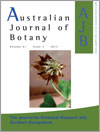Australian Journal of Botany
Volume 61
Number 2 2013
A wildfire on a rock outcrop in south-western Australia killed a population of Calothamnus rupestris Schauer. The species readily regenerated but the seed bank is likely to take ~14 years to recover. The risk of intense wildfires affecting fire-sensitive outcrop communities can be reduced by prescribed burning the surrounding forests.
Slow-growing desert tree species pose unique conservation challenges; their demography is driven by rare stochastic climatic events, remoteness of populations makes monitoring difficult and, consequently, their management is often information limited. In this paper we examine the population ecology of one such species, Acacia peuce. We provide insights as to how monitoring and modelling populations of such species may be achieved to facilitate adaptive management and conservation of this iconic arid-zone tree species.
Some ecosystems burn more easily than others. The question is whether individual plants can benefit from the suicidal behaviour of burning intensely, rather than avoiding burning intensely and living to fight another day. I argue that there is no benefit from burning intensely.
The pioneer plant Calluna vulgaris knows how to survive in one of the most extreme habitats, such as an active geothermal alteration field. Leaves of plants growing at different distances from geothermal hot spots showed a fine-tuned regulation of morpho-anatomical and physiological traits, underlining the plasticity of their complex adaptive response.
Trifolium argentinense is an amphicarpic species. Amphicarpy is a rare mode of reproduction where aerial and subterranean seeds are produced by the same individual. Aerial flowers are cross-fertilised, have more anthers and produce more pollen and seeds than the subterranean flowers, which are necessarily self-fertilised. This species also reproduces vegetatively by stolons and storage roots. Amphicarpy and vegetative reproduction have different ecological functions; aerial seeds increase genetic variability, whereas subterranean seeds and storage roots ensure persistence under adverse conditions.
Boundaries are critical zones for understanding the dynamics of savannahs and forests. We inferred the dynamics of a savannah–forest boundary in New Caledonia from the analysis of vegetation structure and composition. We propose different indicators to identify different phases of the boundary dynamics (stable and unstable phases).
Widespread decline in the health of Mediterranean-type ecosystem (MTE) woodlands can result in low levels of natural regeneration. We undertook field trials over 3 years, with the aim of increasing revegetation success, finding that the mere addition of propagules did not ensure successful revegetation and that the addition of nutrient resources seems to be critical in terms of increasing early seedling establishment in some species. Without this type of information and management-intervention activities, such woodlands could suffer local extinction.
Elevated levels of inbreeding in impacted plant populations may reduce the genetic fitness of seeds and future resilience of populations founded by these seeds. We found that despite habitat disturbance, seeds from populations of tuart (Eucalyptus gomphocephala) showed largely unchanged levels of inbreeding, and this varied within populations more so than among populations. Results highlight the importance of sourcing seeds from multiple trees within populations for ecological restoration, and that habitat disturbance does not necessarily negatively impact the mating system.
Cook’s scurvy grass (Lepidium oleraceum) is a threatened coastal plant endemic to New Zealand. We surveyed wild populations on the South Island’s east coast for three common crop viruses: Turnip mosaic virus, Cauliflower mosaic virus (CaMV) and Turnip yellows virus (TuYV). We show that crop viruses are almost ubiquitous in these populations and report the first record of L. oleraceum as a host for both CaMV and TuYV. The high incidence of virus infection throughout the study populations may make this system one of the first examples of introduced viruses affecting the conservation of a threatened plant species.




